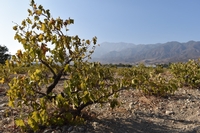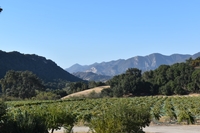I recently got reconnected with my wine roots, thanks to an invitation to write about some hidden vineyards in central and southern California as part of a continuing series on legendary Zinfandel vineyards. The task brought me back to things that attracted me to wine in the first place – the stories of people and places that produced deliciousness in my glass. After an early introduction to wine via finger-hooked jugs of off-dry rosé, it was Zinfandel – the red kind - that got my attention in the early 1980’s and sent me down the road I’ve enjoyed driving on ever since. While on that road, I’ve noticed that the wine writing community has more than its share of “Zinfandel Infidels” who often dismiss domestic wines that start with the letter Z for what they call more “noble” red varieties. I’m here to argue that it’s time for the outsiders to come back in and witness the ongoing renaissance that goes by the nickname “Zin.”
A quick history of the grape: Zinfandel is believed to have come to the USA as early as 1820, winding its way to California by around 1850, and becoming more than a third of California’s planted vitus vinifera vines by 1890. Today, there are still several surviving vineyards from that time period that produce fruit – some still on their own pre-phylloxera roots. In 2001, DNA typing revealed Zinfandel to be from what is now called Croatia – nine surviving vines of a grape called Crljenak Kaštelanski were found to be a genetic match for both the Primitivo grape from the Puglia region of Italy and what we thankfully call Zinfandel domestically. You’ll find a few winemakers out there

that will dispute the relationship between Primitivo and Zinfandel – some wineries even bottling wine under both monikers – but that’s a story for another column.
My history with Zinfandel started in the early 1990’s with a bottle being poured in the Talley Vineyards tasting room just east of the town of Arroyo Grande on California’s central coast. A small bar off to the side of Talley’s main tasting area was pouring a Zinfandel from Saucelito Canyon Vineyards – which at the time was a tiny operation out in the hills east of Lopez Lake. I’m sure I had tasted some Zin before that, but that one remains etched in my memory. The story of what then was an over 100-year-old vineyard and its rescue by Bill and Nancy Greenough was captivating.
Around the same time, Zinfandel Advocates and Producers was founded, and their annual tastings at Fort Mason in San Francisco generated huge interest in the variety, enabling consumers and producers alike to survey the landscape of what was being done with Zinfandel from a stylistic perspective. From the delicate, low alcohol offerings from Nalle Winery to the bombastic 16+% alcohol levels in Martinelli Winery’s bold bottlings, there was seemingly something for everybody.
Through the 90’s and into the 2000’s, a general domestic trend towards what I’ll call the riper side of the wine spectrum seemed to gain traction every year, with wineries embracing longer hang time on the vine that results in more sugar in the fruit at harvest and higher alcohols after fermentation. Many Zinfandel producers naturally jumped on board, and while the public went bonkers for the big wines, many critics lost interest, rightly calling out some wines for their port-like aromas and flavors and generally heavy character.
Then, the Sideways effect. The 2004 film swung domestic wine consumer attention away from all things not Pinot Noir, and as store shelves emptied and wineries scrambled to push out the next vintage of their Burgundian reds, other red grapes, excepting King Cabernet, sat on the sidelines. Zin started to fall off of restaurant wine lists, and corporate producers shifted their eyes toward cashing in on the trend, and left Zinfandel to its more artisanal champions.
This is where the silver lining to the story starts to emerge. It’s important to note here that Zinfandel is finicky. It ripens unevenly, with pips (unripe green grapes) and raisins often found in the same cluster, along with everything in between. Winemakers will tell you it’s harder to manage than even the notoriously temperamental Pinot Noir – a fact that makes it uniquely (and happily) susceptible to terroir influences and harvest choices, not to mention winemaking style choices. Left in the hands of long-time proponents and intrepid newcomers on a mission, the stage for the renaissance was set.
Today, while the wines still run the something for everyone gamut I mentioned above, there’s a refinement across the spectrum that’s difficult to overstate. Longtime pioneers like Joel Peterson of Ravenswood fame and newer torch bearers like Carol Shelton with her eponymous label, Morgan Twain-Peterson (Joel’s son) at Bedrock Wine Co., and Tegan Passalacqua at Turley focus on historic vineyards and newer plantings that have a different profile to offer. Jake Bilbro at Limerick Lane brings second generation know-how to a vineyard with blocks of different ages, and winemaker Tom Greenough is carrying on the tradition at Saucelito Canyon with beautiful expressions of the estate terroir as well as adding in bottlings from other appellations to show the range that Zinfandel has to offer.
One of the keys to variety is the ripeness level mentioned before, and the best Zin makers have worked hard to solve the puzzle of what ripeness level allows a vineyard site’s profile to speak most clearly. I liken it to roasting coffee. As an avid home roaster who likes to tinker with roast levels, I find that the origin of the bean usually speaks more clearly at lighter roast levels, with the darker roast levels tending toward more “roast” character than regional character in most cases. With Zinfandel, a similar situation seems to hold true. The riper the fruit gets, the more it tends toward a jammy or raisin-y character with less peppery freshness in many cases, but certain vineyards can defy this logic when handled carefully. And, while there are still some “over-roasted” examples being produced to satisfy customers, the trend I’m seeing is definitely toward balanced wines that speak of place.
You can find plenty of my Zinfandel reviews here at WRO – I’ve got at least 150 in the archives, and there’ll be more coming. Watch for an upcoming review of a wine from Lodi’s Maitre De Chai that crosses my desk at 12.8%

alcohol (not a typo) from the Stampede Vineyard in the Clements Hills AVA. I’d spill the beans here, but I’m tasting it on a zoom call later this week.
Speaking of virtual tastings involving Zinfandel, National Zinfandel Day is coming up Wednesday November 18th. Zinfandel Advocates & Producers is hosting a Facebook Live virtual tasting of four great Zins, and if you’re quick on the draw you can order the wines that will be tasted and taste along. I’ll definitely be tuning in. Additionally, the ZAP site lists other opportunities to join in the renaissance in the coming months, including a pandemic friendly version of their annual public tasting that they’ve labeled “The Social Zinstancing” in January.
Here’s to seeing you out on the virtual road in pursuit of California’s heritage grape!